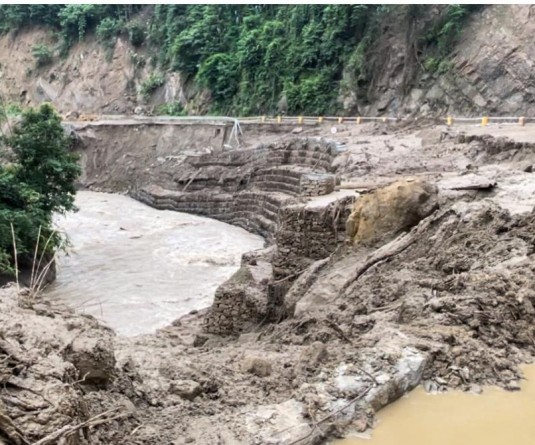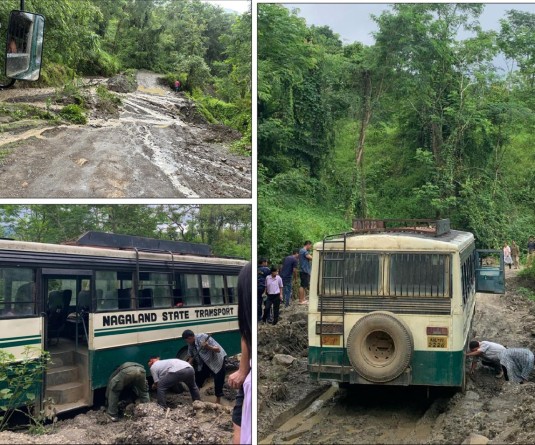The lone fire station responsible for responding to fires and emergencies across all subdivisions, including Sanis, Bhandari and Merapani under Wokha district.

Meribeni T Kikon
Wokha | April 21
In the entire district of Wokha, Nagaland, there is just one fire station responsible for responding to fires and emergencies across all subdivisions, including Sanis, Bhandari and Merapani. While official jurisdiction covers the whole district, the reality on the ground tells a different story.
Second Officer Thenuosielie Pielie, in charge of the Wokha Fire and Emergency Services station, reveals that though they are tasked with protecting the entire district, logistical challenges make it nearly impossible to effectively reach all corners during emergencies.
“Practically, we are unable to cover far-flung areas when there is an emergency because of distance constraints and the travel time involved,” he explains.
The station itself, built roughly 20 years ago by engineers, is now grappling with infrastructure deterioration. The structure remains stable for now, but water leakage from the terrace during the monsoon season has become a recurring problem.
“The infrastructure is weakening. It would be highly beneficial if the building could be upgraded. The government is taking up the issue, and we are hopeful we will get a better facility in the coming days,” says Pielie.
Currently, Wokha Fire Station operates with just three fire engines for the entire district. While the team does have some functional modern firefighting tools, the equipment pool is far from sufficient. “We’re not fully equipped. It is a mix. We have some modern tools that we can use, but many of our other tools have been operating for years. Still, we’re able to use them in emergencies,” he says.
There have been some positive developments. Recently, the station acquired a new water pump that allows them to fill tankers with 5,000 to 10,000 liters of water within five minutes during emergencies. “That pump was much needed, and it’s proven to be very effective,” says Pielie.
However, the lack of basic safety gear remains a major concern. “We are very low on protective equipment,” he shares.
“We don’t have proper firefighting suits. We only use the regular uniforms issued by the government. During firefighting, especially in forest fires, we get scratches and bruises on our hands from thorns and bushes. We have requested for basic items like firefighting gloves, helmets, and face masks.”
He also suggests a seemingly small yet impactful improvement, “If the sirens of ambulances can be modified to produce distinct sounds from those of fire department vehicles.” Since the sirens in fire department vehicles are inbuilt, differentiating the ambulance sirens would help people to easily differentiate between the two during emergencies, he observes.
The station currently has 29 personnel, which Pielie says is not enough. “With the increasing number of districts in Nagaland, we’re seeing posts getting transferred to new districts. Instead of gaining more personnel, it is decreasing. We are lacking in strength. We definitely need more manpower,” he says.
In terms of training, he assures that the staff undergoes an annual refresher course every June, which coincides with the monsoon season, a relatively quieter time for emergencies. “Even though we have refresher courses scheduled, emergencies sometimes disrupt them. But we do conduct them annually without fail.”
Although there are no officially designated specialized teams within the station, the personnel have grown into their roles through years of experience and training.
“We are trained to handle any kind of situation. People assume we only fight fires, but we’re also trained for rescue operations,” Pielie adds.
Ground-level challenges are another issue. “We often face heavy traffic congestion and improper parking on our way to a fire site. Even when we use our sirens, sometimes people don’t make way. I don’t know if it’s ignorance or just negligence,” he says.
“Another issue is that we receive information late. People first try to handle it themselves, and only when it gets out of control do they call us. Then we get blamed that the fire brigade arrives after everything is burned.”
Fire emergencies are most frequent during the dry and windy months of February, March, and April. “That’s when we receive the most calls,” says Pielie.
When large emergencies occur, coordination with other departments such as the State Disaster Response Force (SDRF) and the police is crucial. “We first assess the scale of the emergency. If it's something we can handle ourselves, we do. But if it's a major incident, we immediately coordinate with other departments and respond as a team,” he explains.
The station is also active in community engagement. “Every month, we conduct fire safety drills and awareness campaigns,” he says. “We go to busy markets, schools, colleges, hospitals, and government offices. In the past few years, we’ve covered almost all schools and hospitals in Wokha.”
Pielie ends with a message to the public, stressing the importance of fire safety and preparedness. “As per the National Building Code of India, every building, whether it’s a hospital, school, or private commercial building, should have fire safety systems in place. We’ve conducted inspections and given recommendations, but most institutions are not taking them seriously.
Government hospitals are trying their best, but schools, colleges, and private buildings are not giving it enough importance.”
“Yes, we know installing these systems can be expensive, but safety should come first. If we can take care of basic fire safety requirements, we’ll all be safer. That’s the message I want to give to the people of Wokha.




